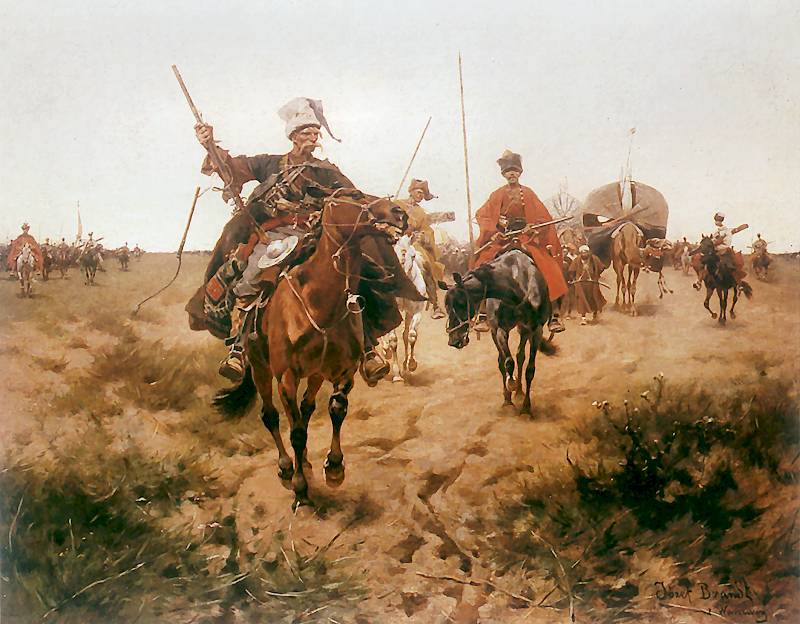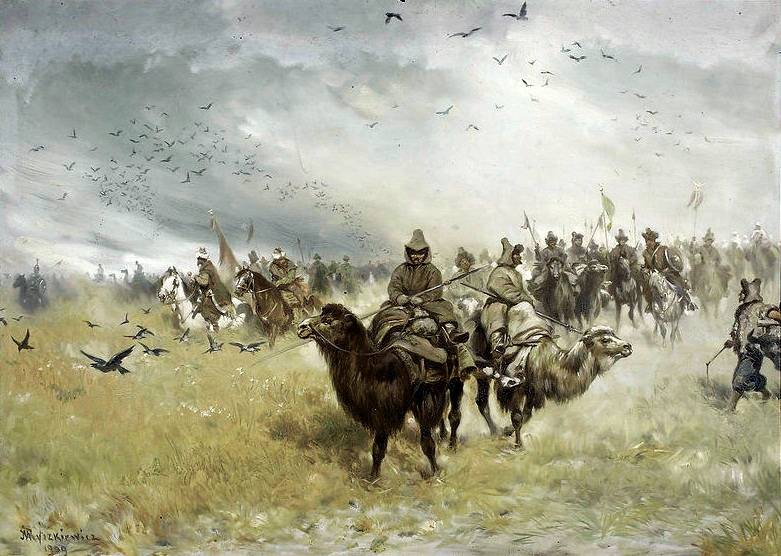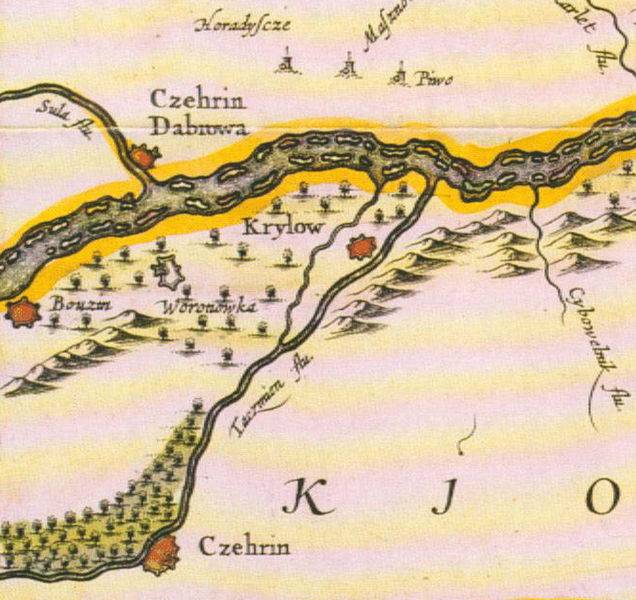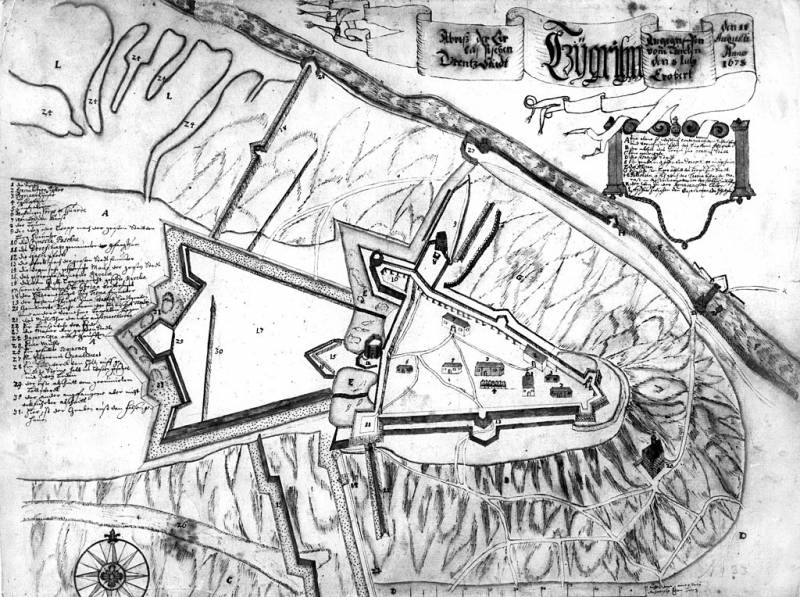Heroic Defense of Chigirin. The defeat of the Turkish army in the Battle of Buzhin

Tabor (Cossacks). J. Brandt
Istanbul's appetites were not limited to Ukraine. The projects of the times of Ivan the Terrible were revived - to subjugate the entire North Caucasus, capture the Volga region, restore the Astrakhan and Kazan khanates under the protectorate of Turkey. Russia had to pay tribute to Crimea as the successor to the Horde.
Defeat of Poland
In January 1676, Tsar Alexei Mikhailovich died. Fyodor Alekseevich, the son of Aleksey and Maria Miloslavskaya, became his heir. He was very weak and sickly, the Miloslavsky family, their singers and favorites, began to play a leading role in the Russian kingdom. In July, the favorite of the deceased Tsar Alexei Mikhailovich, the experienced head of the Ambassadorial Office, Artamon Matveyev, was sent into exile.
The changes in Moscow did not have the best effect on foreign affairs. The right-bank hetman Doroshenko, who had agreed to submit to the tsar, immediately played back, refused to take the oath. At the same time, he did not have troops to undertake something serious. Moscow, waiting for the actions of the Turkish-Tatar army, waited. The governors on the Left Bank were ordered not to start a war with Doroshenko and to act by persuasion.
In the summer of 1676, a new campaign of the Turkish-Tatar army began against the Polish-Lithuanian Commonwealth. The Ottomans of the seraskir (commander-in-chief) Ibrahim-Shaitan-Pasha (for his cruelty he was nicknamed "Shaitan") and the Crimeans of Selim-Girey headed to the west of Ukraine. They captured several small fortresses and laid siege to Stanislav in August.
The Polish army under the command of King Jan Sobieski was assembled near Lvov and advanced to meet the enemy.
Ibrahim Pasha lifted the siege from Stanislav and moved north. Polish troops in mid-September were besieged at the river. Dniester, in a fortified camp near Zhuravno. Since the beginning of October, the Ottomans have been shelling the Polish camp with heavy artillery. Polish troops found themselves in a difficult situation, suffering losses from enemy artillery fire. And they were cut off from supply lines. However, the Turks did not want to continue the siege, fearing the arrival of Polish reinforcements and the approach of winter.
Peace talks began.
On October 17, the Peace of Zhuravensky was concluded.
He somewhat softened the conditions of the previous, Buchach peace of 1672, canceling the requirement for Poland to pay an annual tribute to Turkey. The Turks also returned prisoners. However, Poland ceded a third of the Polish Ukraine - Podolia, Right Bank, with the exception of Belotserkovsky and Pavolochsky districts. It now passed under the rule of the Turkish vassal - Hetman Doroshenko, thus becoming an Ottoman protectorate.
The Diet refused to approve the "obscene" peace.
The Polish elite hoped that in the context of the flared up confrontation between Russia and Turkey, the Ottomans would make concessions to Poland as opposed to Russia.
A delegation was sent to Constantinople with the aim of returning part of Ukraine. Negotiations took place in 1677-1678. The Ottomans refused to yield.
The Istanbul Treaty of 1678 confirmed the Zhuravensky agreements.

Tatars in the vanguard of the Turkish army. Y. Ryshkevich
Deposition of Doroshenko
The resumption of the Polish-Turkish war eliminated the threat of the appearance of the main enemy forces on the Dnieper for the Russian governors.
In September 1676, the troops under the command of Hetman Romodanovsky and Hetman Samoilovich (Cossacks write to the Sultan) united and sent a strong 15 thousand corps of Colonel Kosagov and General Bunchuzhny Polubotok to the Right Bank.
The tsar's troops laid siege to Chigirin. Doroshenko, who had only about 2 thousand Cossacks under his command, was not ready for a siege. He again sent calls for help to the Ottomans, but the Sultan's army was far beyond the Dniester. The Chigirin people were worried, demanded from the hetman to submit. Doroshenko realized that he could not resist until the approach of the Turks and Tatars, and capitulated. The former hetman was allowed to live in Ukraine for some time, and in 1677 he was summoned to Moscow and left at the sovereign's court.
Chigirin was occupied by the tsarist warriors.
The right bank was devastated by the war, there was nothing to feed the troops. The main forces of the Russian army returned to Pereyaslav and were disbanded. Chigirin, which was the capital of the "Turkish hetman" (by agreement in Zhuravno also fell under Turkish control) made the fortress the main point of contention in the ongoing Russian-Turkish war.
Thus, during the campaign of 1676, Moscow achieved the main goal pursued by all the previous years of the war: it removed the hetman of the Right Bank and the Turkish vassal Doroshenko from the political scene, and occupied Chigirin.
However, the Turks were able to crush Poland. And the Russian kingdom faced the threat of a direct clash with the main forces of the Ottoman army.
In the Northern Black Sea region, Russian troops adhered to the previous military plan developed by the head of the Ambassadorial Prikaz Matveyev in 1672-1675. Collected in the lower reaches of the Don, in Ratny town near Cherkassk, the regiments posed a threat to Azov, the Crimean and Turkish coasts (during the breakthrough of the Russian flotilla), fettering significant forces of the Turks and Crimeans.
The Cossacks of Ataman Serko acted on the communications of the enemy army that fought on the Polish front. The threat to Azov led to an almost complete cessation of raids on the Sloboda Ukraine and the Belgorod line.
New "Turkish hetman"
Doroshenko warned the governor of Romodanovsky and the tsar that the sultan already considered himself the master of Ukraine. And Chigirin's surrender means nothing.
The Ottomans will appoint a new hetman and send in an army. The Polish king Sobieski, having concluded peace in Turkey, reported the same to Moscow. He offered to immediately send additional forces to Ukrainian cities. Especially to Kiev and Chigirin. He advised to pay special attention to engineers and artillery, since the Turks are strong in the siege of fortresses and have good artillery.
In Turkey, the post of Grand Vizier was taken by the smart, active and warlike Kara-Mustafa. He did not change the policy of Constantinople towards Ukraine.
The Turks had Yuri Khmelnitsky, the son and successor of Bohdan Khmelnitsky, who had already twice been the hetman of Ukraine, in the store. He was offered the post of hetman and he received the title of "Prince of Little Russia".
Constantinople's appetites were not limited to Ukraine. The projects of the times of Ivan the Terrible were revived - to subjugate the entire North Caucasus, capture the Volga region, restore the Astrakhan and Kazan khanates under the protectorate of Turkey. Russia had to pay tribute to Crimea as the successor to the Horde.
The Turkish embassy arrived in Moscow and made demands - to leave Ukraine, to destroy the Cossack villages on the Don. The Russian government responded harshly: the Cossacks will remain, we will take Azov, as well as the lands on the Dniester.
However, it was already known that the Ottoman army in April 1677 began to cross the Danube. Ibrahim Pasha commanded the Ottomans. Under his command there were 60–80 thousand soldiers, including 15–20 thousand Janissaries, 20–40 thousand cavalry, about 20 thousand Vlachs and Moldavians, 35 guns. At the end of June, the Turks crossed the Dniester at Isakche. On the Dniester near Tyagin, the Ottomans united with the Crimean horde of Selim-Girey. The number of the Turkish-Tatar hordes reached 100-140 thousand people, not counting carts, servants, workers and slaves.
The Ottomans' intelligence was bad. They proceeded from erroneous data on the weakness of the Russian garrison in Chigirin (4-5 thousand people). It was believed that Kiev was not ready for defense, there were few weapons and supplies. Therefore, it was planned to take Chigirin in a few days. Then Kiev and occupy the entire Right Bank in one summer campaign.
Also, the Ottomans, apparently, took denunciations of Polish and Ukrainian traitors at face value. They hoped that the Cossacks were hostile to the tsar and were just waiting for the opportunity to rebel. That the population of the Right Bank will go under the arm of Khmelnitsky. And the tsarist garrisons will have to go beyond the Dnieper. In the next campaign, the Left Bank will also be conquered.
With the army of Shaitan Pasha, there was also a tame hetman. His retinue initially consisted of only a few dozen Cossacks (then increased, according to various estimates, to 200 or several thousand Cossacks). But this did not bother the owners. Yuri began to send out letters - "universalists", promised peace and security to those who recognize him as hetman. Summoned under his banners the right-bank Cossacks and Cossacks Serko.
Yuri's universals were not successful. The Russian people on the Right Bank have already experienced all the "joys" of the Ottoman authorities. The Cossacks did not support the new Turkish protege. Ataman Serko, fearing the appearance of a large enemy army in the Sich, concluded an armistice with the Crimean Khan. And the Cossacks during the campaign of 1677 observed neutrality.
Plans and forces of the Russian command
Based on the experience of the Polish-Turkish war, on information about the quality and condition of the Sultan's army, Hetman Samoilovich and other military leaders suggested limiting themselves to active defense. Wear out the enemy with the siege of Chigirin, supplying the fortress with everything necessary, wait until late autumn. With the approach of winter, the Turks, unable to winter in the devastated lands of Little Russia (there are almost no villages around Chigirin for the years of the Ruins), will leave for the Danube, to their bases and warehouses. At this time, Russian regiments can successfully pursue the enemy and inflict great damage on him.
In Ukraine, the tsarist regiments occupied Kiev, Pereyaslav, Nizhyn and Chernigov. In Chigirin there was a fairly large 9 thousand garrison of Russian infantry and Cossacks under the command of General Athanasius Traurnicht (a German in Russian service).
The fortress was strong and consisted of three parts: the castle ("upper town"), "lower town" and the posad. Part of the fortifications was made of stone, part of it was made of wood; on three sides they were covered by the river. Tyasmin (tributary of the Dnieper).
But during the previous campaigns, it was seriously damaged, the walls were bombed, burned. The posad was burned and never rebuilt. A rampart and wasteland remained in its place. Just from this side, from the south, Chigirin was not covered by the river.
The Chigirin artillery consisted of 59 guns, and the riflemen also had regimental 2-pounder squeaks. Some of the guns after past battles were out of order, did not have carriages. The supply of nuclei for the siege was small, but provisions and gunpowder were sufficient. The Chigirinsky garrison had to withstand the attacks of the enemy until the main forces of the Russian army and the Ukrainian Cossacks approached.
Samoilovich's Cossack regiments gathered in Buturlin (20 thousand). Prince Romodanovsky with the main forces of the Belgorod and Sevsky categories, elective regiments and a number of other detachments gathered in Kursk (about 40 thousand). The big regiment of boyar Golitsyn is in Sevsk (about 15 thousand). The army of his "comrade" devious Buturlin is in Rylsk (7 thousand). Later in June, another detachment of Prince Khovansky (9 thousand) was formed, which strengthened the defense of the Belgorod line. Additional shelves were also assembled in the center and in the north. In total, under the leadership of Golitsyn, it was planned to collect 100 thousand army, which guaranteed parity with the enemy.
Siege of Chigirin
On July 30, 1677, the advanced forces of the Tatar cavalry reached Chigirin. On August 3-4, the main forces of the enemy army reached the fortress.
On August 3, the Russians made their first sortie. The 4th was repeated with large forces - 900 archers and more than a thousand Cossacks. The battle on the old shaft continued until the evening. Our troops drove the enemy off the rampart and returned to the city. At night, the Ottomans assessed the chances and on August 5, the Turkish commander offered the garrison to surrender, but was refused. The Turks opened fire on the fortress, partially suppressed the artillery of the fortress (there were few heavy weapons) and demolished the right part of the wall.
On the night of August 6, the Ottomans pushed the field fortifications forward, moved the batteries and resumed shelling in the afternoon. The next night, they moved forward again and continued the methodical destruction of the fortress wall. The defenders were fixing what would happen, but they did not have time to patch up all the gaps. The Turks moved forward again and were already 20 fathoms from the wall, firing almost point-blank. On the morning of the 7th, our troops made a sortie, threw grenades at the enemy, went into the "axes and darts" (they did not know the bayonets yet), and captured the nearest trench. The besieged poured a new rampart behind the wall, on which cannons were installed.
On August 9, the half-headed rifleman Durov made a strong sortie. The Ottomans were forced to pull up reinforcements and only with their help they threw the Russians back into the fortress.
The Turks dug at the Spasskaya Tower, a powerful explosion destroyed part of the wall. Turkish troops in large forces went to the assault. However, our troops drove the enemy back. Then the Ottomans tried to attack at the Goat Horn Tower, but also without success.
On August 17, the enemy undermined the "lower city", blew up a section of the wall of 8 fathoms and began an assault. The Turks captured the section of the breach. Mournicht counterattacked with the forces of 12 hundreds of riflemen and the Cossacks. The attack was repulsed. This success greatly encouraged our troops. After that, the Turks weakened the onslaught, limited to artillery shelling. They dug under the Goat Horn tower, but they found it in time and filled it up.
The Russian garrison continued to make sorties. The Ottomans filled up the moat at the Spasskaya Tower and the Goat Horn, filled the fortress with incendiary arrows and fired at them from mortars. The external fire led to heavy losses of the garrison.
Our troops were already going to the rescue of Chigirin. First, several hundred Cossacks made their way. On August 20, reinforcements sent by Romodanovsky and Samoilovich, about 2 thousand dragoons and Cossacks of Lieutenant Colonel Tumashev and Zherebilovsky, broke through to the fortress. The cavalry at night passed through the forest and swamp to the Korsun tower, entered in formation and with banners unfurled.
On 23 August, gunfire was heard on the Dnieper. It became clear that help was near.
Large forces of Turks and Tatars moved to the river to prevent the crossing of the Russian army. Having failed at the Buzhin ferry (27-28 August), the Turks organized the last assault. The attack was furious. The bombing was the worst ever. Then the Turks filled up the moat in several places and began to erect a mound (embankment) to bring it up to the height of the fortress walls. However, our troops stopped the enemy with heavy fire and grenades.
On the night of August 29, Ibrahim Pasha burned down the camp and took the troops away. The Ottomans took the guns, but threw in large stocks of grenades, cannonballs and provisions.
The losses of the Turks during the siege were about 6 thousand people, ours - 1 thousand people killed, and even more wounded.
The Cossacks set up a pursuit, killed several hundred people, and captured a lot of prey.
Buzhin battle
At the end of July 1677, Romodanovsky's army headed for Ukraine. Getman Samoilovich set out from Baturin on August 1. On August 10, the forces of Romodanovsky and Samoilovich joined up (over 50 thousand people) and moved to the Buzhin ferry.
A detachment of Lieutenant Colonel Tumashev was sent to Chigirin, who on the 20th successfully arrived at the fortress and raised the morale of its defenders. On August 24, the main forces of the tsarist army reached the Dnieper. And its forward units immediately occupied the island in the crossing. Several batteries were installed on the island. Ibrahim Pasha and Selim Girey moved all the cavalry with part of the infantry to the crossing. On August 25-26, preparations were under way to force the river, watercraft were being prepared, and pontoon parks were being pulled up.
On the night of August 26-27, our forward forces under the command of General Shepelev, with the support of coastal batteries, crossed the river. The Turks and Tatars were unable to disrupt the landing. Having seized the bridgehead, our troops began to build field fortifications. Pontoon bridges were built under their cover. In the morning, Kravkov's second elective regiment was transferred to the right bank (these were the regiments of the "new order"). Behind him, other regiments began crossing, including Patrick Gordon's regiment.
In the afternoon, when the Russians had already fortified themselves, they were attacked by the Janissaries. Gordon recalled that the Janissaries were walking
The enemy was met with rifle fire from behind the field fortifications, buckshot from light cannons. Those who broke through to the fortifications were beaten in hand-to-hand combat. The cavalry attacked behind the janissaries. She was repelled by rifle and cannon volleys. Ibrahim Pasha was informed that the son of the Crimean Khan, many murzas and commanders had died.
As a result, the Russian troops repelled the enemy attack. The river was already crossed by 15 thousand warriors, who launched a counterattack and pushed the enemy back. On August 28, our troops continued their offensive, completed the crossing and expanded the occupied bridgehead. The enemy was thrown back several miles from the Dnieper.
The Ottomans retreated, losing up to 10 thousand people. Our losses are about 7 thousand people.
Thus, in the battles of August 24-28, our troops, with the support of artillery fire, seized a bridgehead on the right bank, repelled enemy attacks and ferried most of the infantry there. The Ottomans retreated from the Dnieper.
Also on August 29, on the Dnieper near Chigirinskaya Dubrovka, opposite Voronovka, an auxiliary army of governors Golitsyn and Buturlin appeared. The Turkish command (after failures with the assault on Chigirin, on the crossing of the Dnieper) did not dare to accept a decisive battle (fearing encirclement and defeat), lifted the siege and led the troops across the Bug and Dniester.
At the same time, artillery and supplies were left on the Dniester in the expectation of their use in the campaign of 1678.
On September 5–6, the troops of Romodanovsky and Samoilovich reached Chigirin. The horse detachment of Kosagov and Lysenko followed the enemy army. He reached the river. Ingul and found out that the enemy had gone beyond the Dniester.
Chigirin himself presented a terrible picture. The foreground was dug up by trenches, the walls were destroyed, and numerous mines were made under them. Almost all of the fortress artillery was put out of action. The ammunition is running out. The Chigirin garrison was replenished, the fortress began to be restored. After that, the army was withdrawn across the Dnieper and disbanded until spring.
Thus, the campaign of 1677 ended with the victory of the Russian army.
Chigirin was held back, enemy plans to conquer the Right Bank were thwarted.
However, the victory was not decisive.
The tsarist command did not strive for a general battle, but on the whole the planned plan was implemented. The major victory of the Russian army at Buzhin was highly regarded at that time. They were jubilant in Russia.
All participants of the company were awarded. Officers - promotions in ranks, sables. Streltsov, soldiers and Cossacks - with salary increases, cloth and
officially embossed for this occasion (they were used as medals).
At the Port, this unexpected failure, especially in connection with bright hopes, was taken extremely painfully. The Sultan scolded the commander-in-chief. Ibrahim Pasha was removed from the main command, thrown into prison, he was replaced by the grand vizier Kara-Mustafa. The Crimean Khan Selim-Girey, who clearly did not want to trample under Chigirin (there was no booty in the devastated area), at the beginning of 1678 was deposed and replaced by the more obedient Murad-Girey. Turkey began to prepare for revenge for the defeat of 1677. In Moldova, they began to prepare food and fodder.

Chigirin and Buzhin area on the map of Kiev Voivodeship. Jan Jansson. Amsterdam, approx. 1663 g.
- Alexander Samsonov
- https://ru.wikipedia.org/

Information